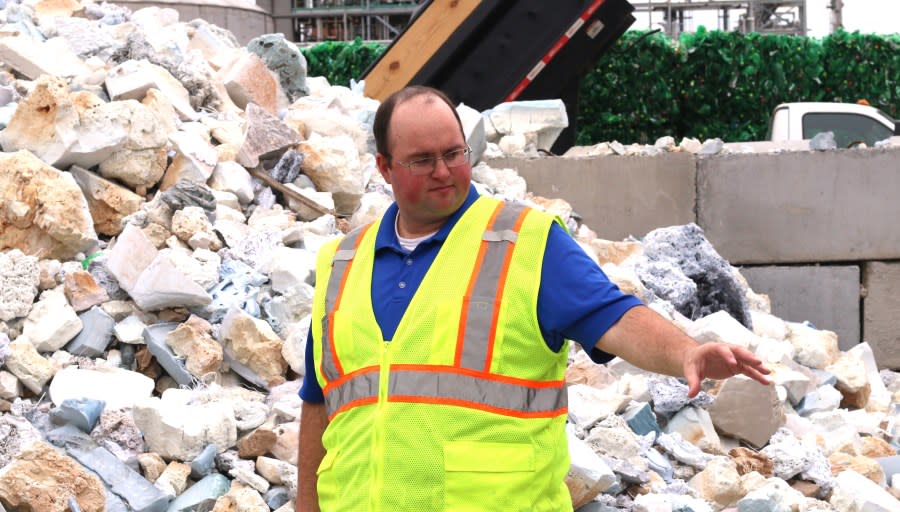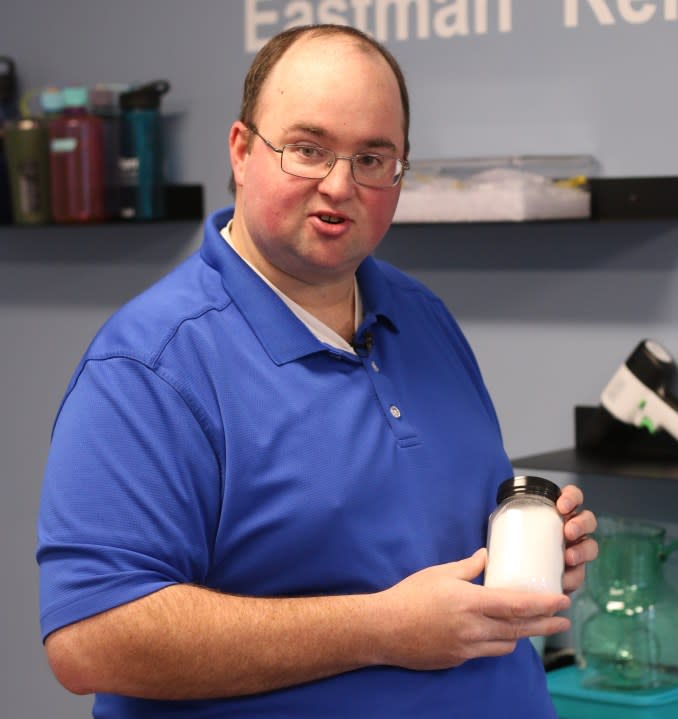‘Chunk,’ ‘nerds’ and densifiers — Eastman’s molecular recycling explained
Note: Eastman Chemical Company’s first “molecular recycling” facility is now fully operational in Kingsport. It uses a process called methanolysis to reduce hard-to-recycle waste plastic to its original molecular state for reuse in plastic production. Eastman expects the main end product, recycled “DMT,” to capture large market share in durable plastic and packaging sectors because of it removes plastic from the waste stream and makes progress toward a “sustainable economy.” News Channel 11 got an exclusive first look around the facility and brings you this and other related stories.
KINGSPORT, Tenn. (WJHL) — Spencer Tidwell remembers it vividly: walking into a vast, empty warehouse designed to hold a massive amount of compressed, baled waste plastic for Eastman Chemical Company’s molecular recycling efforts.
RELATED: Eastman reckons recycled DMT production will benefit area recycling programs
The chemical engineer had been working on pilot efforts since 2016 as Eastman worked to scale up its process for turning waste plastic of nearly any type imaginable into “virgin grade” — but recycled — dimethyl terephthalate (DMT), which is the building block for many PET plastics. He and colleagues had been “failing fast,” quickly figuring out what did and didn’t work.
“How do we effectively clean it, prepare it and get it to the point where we can efficiently and effectively convert it to new material,” Tidwell said of the root challenge the team had been trying to solve.
Now Eastman was on the cusp, it seemed, of being able to process 110 metric tons of plastic waste annually and produce about 90% of that weight into the so-called R-DMT that Tidwell’s colleagues in suits and ties were convinced the world was wanting for its recycled content and lower carbon footprint. It was time to start filling up that warehouse, then emptying and filling it in a constant loop.
“When I walked into the warehouse for the first time, it was empty,” Tidwell said. “I’d done the math and I was like, ‘Okay, if we fill this up we’re gonna consume it within four days or something.’ And I was like, ‘Oh my goodness.'”

For comparison’s sake, Eastman spokespeople like to talk about Neyland Stadium, the 101,915-seat University of Tennessee football stadium 100 miles down the road. Those 110 metric tons of plastic waste would fill the stadium two-and-a-half times over.
Shredding, densifying and washing
Tidwell and other scientists developed and scaled up three main processes to take everything from carpet fibers and colored plastic containers to strapping and castoff materials from mechanical recyclers and turn them into DMT. Since March, all of them have been actively processing huge amounts of waste plastic at Eastman’s new “mixed plastics processing” facility, preparing so-called “feedstock” for the machines that then churn out R-DMT in much the same way as they create old-school DMT from “virgin” materials.
One process uses shredders to take large pieces of plastic, including waste castoffs from mechanical recyclers, and turn them into smaller particles that can flow into the reactor.
Tidwell held up a green, heavy piece of plastic that Eastman’s shredder will turn into those smaller particles.
“This is a PET or Number One plastic chunk,” he said. “This is actually a reject from the mechanical recycling process. This particular day they were running green bottles and they had green purge, basically molten polymer that didn’t meet (specifications) that they had to get rid of.”
Instead of sending that chunk to landfills, mechanical recyclers can (and do) now send it to Eastman.
RELATED: Eastman execs see lucrative future for molecular recycling
Another process uses what are called densifiers, Tidwell said. They can take everything from t-shirts and carpet fiber to monofilament like toothbrush or paintbrush bristles and “turn those into small agglomerates as we call them, small pellets that can be fed effectively into the process.”
As long as the waste is created from PET, or polyethylene terephthalate, Eastman can convert it for the R-DMT process. “It’s just a form difference,” Tidwell said, holding a bag of the “densified” pellets that look strangely like Nerds candies.
Another type of feedstock needs an extra step after shredding. It heads to the “wash line.”
“This is what you would think of when you think about curbside recycling,” Tidwell said. “When you’re putting your articles into the bin, that’s the type of feedstock that is going to come in and be processed on the wash line.”

Mechanical recyclers can only use clear or relatively clear plastic, making things like detergent or shampoo bottles a contaminant for them. When those plastics come in to mechanical recyclers, they send them on to landfills or waste-to-recycling incinerators — a fact that has caused a lot of municipalities to quit taking those types of type 1 and 2 PET plastics.
Tidwell said Eastman hopes to “grow the pie” so municipalities will begin accepting those opaque plastics again.
“Have this be accepted at the curb and then we become an outlet for it when it gets sorted out and we can feed it and process it into our lines,” he said. The same goes for plastic types 3 through 7, including the Number 5 plastic commonly used in things like yogurt and sour cream containers.
Once shredded into what Tidwell called “flake,” those plastic flakes are fed into a water bath.
“Anything that’s PET will sink to the bottom of the water and anything that is polyethylene, or polypropylene or polystyrene, some of the other plastics will float,” Tidwell said.
The PET that sinks to the bottom makes its way with the densified nerds and shredded chunk over to Eastman’s methanolysis facility for R-DMT production. The floating bits go to another part of Eastman’s “carbon renewal technology” or be sold off to an olefin recycler.
‘Showing the world what’s possible’
Like his colleagues on the sales and management side, Tidwell managed to work Eastman’s major “circular economy” tagline into his conversation: “Showing the world what’s possible.”
“We’re working on something much bigger than ourselves,” said Tidwell, a Louisiana native and Tennessee Tech graduate. “What I would call a once-in-a-career type opportunity and much more than just impact to the company, but obviously impact to the world.”
He said the company hopes to get increasing amounts of its feedstock from “post-consumer” sources, whether that be things like clothing from the growing “fast fashion” industry or difficult-to-recycle plastic waste.
Regardless of the source, though, the Eastman R-DMT products are taking already used material and getting about 90% of the waste volume back into the same condition as the consumer products produced from “virgin” materials.
ETSU men’s golf receives apology from Delta Airlines after baggage mishandling video goes viral
“This is a plaque that we make in the lab and this was made from virgin paraxylene-derived material, fossil material,” Tidwell said, holding up a dark piece of hard plastic. “This is a Tritan polymer, just in a black.”
“And then this is the Tritan plaque that we’ve made from these purple shampoo bottles,” he said. “You can hold them and look at them and hold them up to the light and what you see is, they’re indistinguishable from one another.”
One, though, came from about a 10-step process that included extracting raw materials from the earth and transforming them into carbon-emitting petroleum-based feedstock. The other didn’t, and that’s what Tidwell and his Eastman colleagues like Chief Technology Officer Chris Killian are banking on the world buying into — and even paying a premium to get.
“I’ve been involved in the innovation world for a long, long time and it’s been very, very recently that consumers, regulators have made a major shift in how important improved carbon footprint of a product is and how important it is to incorporate recycled plastics into consumer and branded products,” Killian said. “And the world needs technology like this.”
Copyright 2024 Nexstar Media, Inc. All rights reserved. This material may not be published, broadcast, rewritten, or redistributed.
For the latest news, weather, sports, and streaming video, head to WJHL | Tri-Cities News & Weather.

